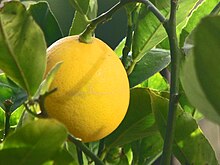梅爾檸檬
梅爾檸檬(學名:Citrus meyerii),又名:北京檸檬、邁爾檸檬、邁耶檸檬、野檸檬、中國檸檬,是一種原產自中國的雜交柑橘屬水果。不同於尋常檸檬和苦檸檬,這是枸櫞與橘/柚的雜交品種。[1]
| 梅爾檸檬 | |
|---|---|

| |
| 科學分類 | |
| 界: | 植物界 Plantae |
| 演化支: | 維管束植物 Tracheophyta |
| 演化支: | 被子植物 Angiosperms |
| 演化支: | 真雙子葉植物 Eudicots |
| 演化支: | 薔薇類植物 Rosids |
| 目: | 無患子目 Sapindales |
| 科: | 芸香科 Rutaceae |
| 屬: | 柑橘屬 Citrus |
| 種: | 梅爾檸檬 C. meyerii
|
| 二名法 | |
| Citrus meyerii Yu.Tanaka
| |
成齡樹高約6至10英尺(2至3米),葉片深綠色帶有光澤。花朵香氣撲鼻,自內往外為紫色和白色。果實比純正的檸檬更圓,成熟時呈深黃色,略帶橙色調,並且口感較甜,低酸。這種檸檬的高酸性ph值介於在2和3之間,汁水酸性比純水高至一萬至十萬倍。[2]這種酸度水平可以將其用作消毒清潔劑。
植物獵人弗蘭克·尼古拉斯·邁耶,被美國農業部派遣至亞洲收集新的植物物種,隨後在中國本土發現了該檸檬品種。[3]在1908年將其以S.P.I. #23028引進了美國。[4]《今日醫學新聞》發表一側總結了幾項研究的時事通訊,表明了這種檸檬可能對健康的一些益處,包括降低中風的風險,調節血壓,預防癌症,並且高含量的維生素C可以加強免疫系統[5]。另外果實中的植物化學物質可以幫助改善情緒,緩解焦慮和減輕體重。[6]。
Citrus meyerii在中國通常被養在花盆中用作園藝植物。而在美國更為熟知用作食物,在20世紀70年代加州美食興起時,像是愛麗絲·沃特斯的主廚們發掘了其中的美味[7][8],也隨著瑪莎·史都華在她的菜譜里推薦起這種檸檬後,知名度迅速地被打響。[3]
描述
編輯Citrus × meyeri成齡樹高約6至10英尺(2至3米),不過可以被修剪得更小。葉片深綠色帶有光澤。花朵香氣撲鼻,自內往外為紫色和白色。[9]
果實黃色,比純正的檸檬更圓。[9]外果皮薄,帶有香氣, 在成熟時呈深黃色,略帶橘色調,汁胞也呈深黃色,相較於市面常見的里斯本與尤力克檸檬,口感微甜低酸,[9]最多生有十個到二十個種子。
培育
編輯Citrus meyerii有著體積小、耐寒和高產的特點,而被青睞用作園藝植物。且植株具有觀賞性適合盆栽養殖。果實在眾多檸檬品種中是最甜的之一,外果皮口感好也可被用作烹飪。[10]盆栽地栽都可,樹株每天至少需要8個小時的光照。在太陽猛烈的夏季需要注意避免過度光照。[11]樹株具有一定的耐寒性,適合在溫帶生長。生命力相當強,栽種後第四年開始結果,在整個生命周期中會結出數千個檸檬。[來源請求]土壤需要排水良好,乾濕平衡。[10]在生長期還需要施緩釋性高氮肥料,可為了最大量收成,到了冬季除非是葉子發黃則不需要。[12]一年四季都可結果,大多是在冬季收成。 [13]新生的分枝為了保護嫩芽形成突刺,之後會化成二級分枝。適當地修建可以給果實騰出適當空間,空氣流通可維持植株的健康,免受疾病侵害。[12]
鳳蝶幼蟲會非常著迷食用其新葉。
烹飪用途
編輯汁水通常被用來調酒和檸檬水。還可醃製肉類,軟化肌肉纖維改善口感。低pH可使肌肉蛋白質變性,使肉更具風味。還可以代替醋進行調味,改善蔬菜的外觀和口感,起防腐劑的作用。[14]外果皮蘊藏果膠,可用作食品的增稠劑和穩定劑,還可刨成削拿來增添風味。[14] 葉片還可泡茶及醃肉。
改良
編輯到了20世紀40年代中期,已經被廣泛種植在加利福尼亞州。然而同時被發現這些無性繁殖的植株都是柑橘萎縮病毒的帶原者。[15]為了保護其他檸檬樹大部分都被銷毀。
在20世紀50年代發現了一種無病毒品種果樹,[16]並於1975年經加利福尼亞大學認證為Citrus × meyeri 'Improved'。[17][18]
參考文獻
編輯- ^ Curk, Franck; Ollitrault, Frédérique; Garcia-Lor, Andres; Luro, François; Navarro, Luis; Ollitrault, Patrick. Phylogenetic origin of limes and lemons revealed by cytoplasmic and nuclear markers. Annals of Botany. 2016, 11 (4): 565–583. PMC 4817432 . PMID 26944784. doi:10.1093/aob/mcw005.
- ^ Lemon Juice: Acidic or Alkaline, and Does It Matter?. Healthline. [2020-05-06]. (原始內容存檔於2021-01-12) (英語).
- ^ 3.0 3.1 O'Hara, Julie. The Meyer Lemon: More Than A Pretty Face. National Public Radio. 18 February 2009 [2009-02-20]. (原始內容存檔於2018-06-16).
For more than a century, the Meyer lemon was known mostly for its looks. In its native China, it was primarily a decorative houseplant. The Meyer lemon might still be decorating homes today if it weren't for one man. In the early 1900s, the U.S. Department of Agriculture sent Frank N. Meyer, an agricultural explorer (yes, that was his actual job title) on several trips to Asia with the mission of collecting new plant species. Among more than 2,500 plants that he introduced to the U.S., the Meyer lemon was named in his honor. Sadly, Meyer would never live to see the success of his namesake. He died on an expedition near Shanghai in 1918.
- ^ Lemon. Hort.purdue.edu. [2014-06-09]. (原始內容存檔於2019-11-26).
- ^ Lemons: Benefits, nutrition, tips, and risks. www.medicalnewstoday.com. [2020-05-06]. (原始內容存檔於2021-03-08) (英語).
- ^ Kennedy, D O; Wake, G; Savelev, S; Tildesley, N T J; Perry, E K; Wesnes, K A; Scholey, A B. Modulation of Mood and Cognitive Performance Following Acute Administration of Single Doses of Melissa Officinalis (Lemon Balm) with Human CNS Nicotinic and Muscarinic Receptor-Binding Properties. Neuropsychopharmacology. 2003-05-15, 28 (10): 1871–1881. ISSN 0893-133X. PMID 12888775. doi:10.1038/sj.npp.1300230 .
- ^ Lowry, Patricia. When life hands you Meyer lemons, life is sweet. 匹茲堡郵報 (Pittsburgh). February 12, 2009 [2020-10-28]. (原始內容存檔於2013-05-23).
Meyer lemons are sweet, thin-skinned and famous for their ethereal perfume. Although common in California backyards, they are just beginning to be commercialized. Ask your friends or relatives in California to send you some," Alice Waters wrote in her Chez Panisse Cafe Cookbook in 1999. A decade later you don't have to beg, thanks in part to Waters' championing of the Meyer and to more growers entering commercial production.
- ^ Domestic Programs. Slow Food USA. [2014-06-09]. (原始內容存檔於2012-11-24).
- ^ 9.0 9.1 9.2 Christman, Steve. 1067 Citrus meyeri. Floridata. 10 February 2018 [3 August 2018]. (原始內容存檔於2018-06-16).
- ^ 10.0 10.1 Learn How to Grow a Beautiful Meyer Lemon Tree in a Pot. The Spruce. [2020-05-06]. (原始內容存檔於2021-01-20) (英語).
- ^ Meyer Lemon Tree Care – Learn About Growing Meyer Lemons. Gardening Know How. [2020-05-06]. (原始內容存檔於2021-03-08) (英語).
- ^ 12.0 12.1 Lemon Tree. doi:10.31096/wua121-nos_461.
- ^ Citrus Variety Collection: Improved Meyer. University of California Riverside. 2002-05-28 [2014-06-09]. (原始內容存檔於2021-03-01).
- ^ 14.0 14.1 All About Lemons. RecipeTips.com. [2020-05-06]. (原始內容存檔於2021-03-08).
- ^ Lee, Richard F. Chapter Five – Control of Virus Diseases of Citrus. Advances in Virus Research. 2015, 92: 143–173. PMID 25591879. doi:10.1016/bs.aivir.2014.10.002.
- ^ Four Winds Growers: Meyer Lemon Origins. FourWindsGrowers.com. (原始內容存檔於5 Oct 2010).
- ^ Markoulakis, Sophia. Meyer Lemon Sweet Enough To Squeeze (PDF). Master Gardener News – Amador County. University of California Cooperative Extension: 6. May 2005. (原始內容 (PDF)存檔於7 March 2006).
- ^ Reuther, Walter; Leon Dexter Batchelor; E. Clair Calavan; Herbert John Webber; Glenn E. Carman; Robert G Platt. Citrus Industry: Crop Protection. University of California. 1989: 195 [2020-10-28]. ISBN 978-0931876240. (原始內容存檔於2021-11-18).